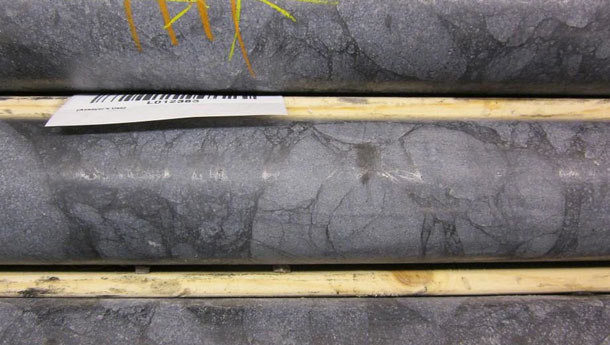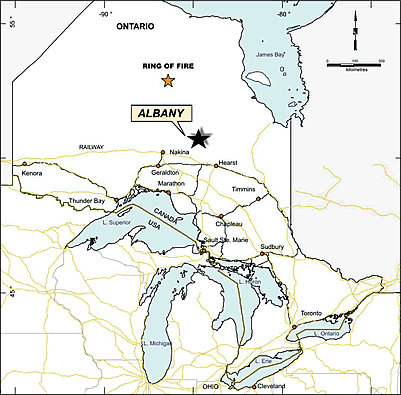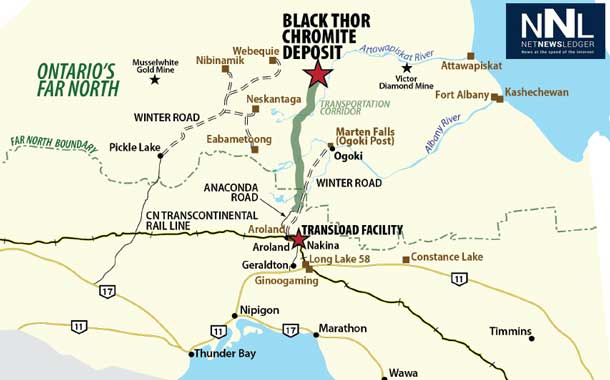
THUNDER BAY – Business – The Arc of Fire might be more exciting than the Ring of Fire. Graphite discoveries are offering great excitement in Northwestern Ontario. The potential of the Ring of Fire has generated a lot of excitement in Northwestern Ontario. However it might be that the real sleeper is graphite. The potential of graphene might be more exciting in the longer run than chromite.
Arc of Fire Graphite Excitement
One of the exciting players in the mining of graphite in Northwestern Ontario is Zenyatta Ventures Ltd.
Graphite and Graphene more exciting than Chromite?
Zenyatta Ventures Ltd. has just announced the results from a third series of beneficiation tests conducted at SGS Canada Inc. (“Lakefield”) on core samples from its 100% owned Albany graphite deposit. The entire 170 metre graphite zone from drill hole 5 was used for this testing.

All trials using a simple caustic baking leach process conclusively demonstrated that an ultra-high purity graphite product with greater than 99.97% Carbon (“C”) can be produced from the Albany graphite deposit. The process was successfully applied to a variety of graphite concentrate samples that had initial carbon grades in the range of 46 – 90% using conventional flotation techniques. In all trials the final purity values were greater than 99.97% C and up to 99.99% C in many cases, regardless of initial carbon grades.
The “Arc of Fire” consists of several large multi-phased mafic-ultramafic-alkalic complexes forming an arc line approximately 150km long. One of these complexes, called the Nagagami River Alkaline Ring Complex, shows similarities to the Mid-Continent Rift related Coldwell Complex on the north shore of Lake Superior. The “Arc of Fire” is believed to also represent a deep seated Proterozoic structure that may be related to the 1.1 Billion year old Mid-Continent Rifting. The Mid-Continent Rift is a known deep seated structural environment that hosts a number of significant mineral deposits around Lake Superior, including the recently discovered Rio Tinto’s Eagle and Tamarack Cu-Ni deposits and Magma’s TBN PGM deposit.

Aubrey Eveleigh, President and CEO comments, “Achieving these ultra-high purity carbon values at such an early stage from a simple and relatively inexpensive process is extraordinary. The graphite purification process is effective across a wide range of initial concentrate grades and particle sizes, producing ultra-high purity graphite with good recoveries. This is a very significant development for the Albany deposit and shows how easily the graphite material can be purified.”
Under the guidance of Don Hains, P.Geo, MBA, an industrial minerals and marketing specialist, Zenyatta now intends to provide a 5 tonne mini bulk sample to Lakefield from core samples to scale up and optimize the process in the coming weeks.
Zenyatta in a media release states, “It is very important to note that there was no mixing of the graphite slurry during all the scoping tests. The use of a mixer (rotary kiln) would greatly improve the mass and heat transfer of the reaction, and would likely result in reaching these ultra-high purity levels quicker and with even better NaOH utilization. The initial flow sheet developed for the process is relatively simple, utilizes known equipment, and provides for recovery of the caustic soda. Studies are also underway to characterize the properties of the purified graphite for selected market applications.”
These latest purity results are further confirmation of earlier mineralogical and beneficiation studies that showed the Albany graphite material to be of high quality and containing insignificant amounts of impurities. The ability to produce a natural graphite product, equivalent in purity to the highest grade synthetic graphite, using low-cost conventional processing techniques will allow Zenyatta to target the growing market in high value-added graphite applications. With growing global interest in the Albany graphite deposit, Zenyatta will continue to discuss the merits of the project with end-users and potential strategic partners.
Natural graphite material has varying levels of quality depending on the type (vein, flake or amorphous). The degree of purity can vary greatly, which heavily influences the use of the material in applications and its pricing. Carbon purity of natural graphite can generally range from 70.0% all the way to 99.0%, whereas synthetic graphite is usually greater than 99.0%. Given the ultra-high purity at Zenyatta’s Albany project, the Company will be positioning the material to compete in the $13 billion (1.5 million tonnes annually) synthetic market.
Synthetic graphite is significantly more expensive to make but commands the highest market prices due to its purity. It can cost $4000 – $5000 per tonne (greater than 99.5% purity) to produce but can be sold for $7000 – $9000 per tonne. Ultra-high purity (greater than 99.9%) graphite can demand a price of $20,000 – $30,000 per tonne. Processing and purification of natural graphite has improved greatly in recent years and projects with initial high purity graphite, like the Albany vein-type, require less purification and therefore lower cost to produce.
Synthetic graphite producers are faced with escalating energy costs associated with turning petroleum coke into graphite. Petroleum coke is the solid waste remaining after refining oil. To turn petroleum coke into graphite requires extensive thermal treatment (up to 3000 degrees C), in various steps, to burn off impurities and re-arrange graphite layers. Not only is this energy intensive but also an environmental issue. Another big concern for synthetic producers is the diminishing supply of petroleum (needle) coke derived from low sulfur, sweet crude oil. Therefore, natural high purity graphite is gaining traction over synthetic graphite for many applications due to lower cost of production. Also, natural graphite has superior qualities such as higher specific capacity and less porosity.
Zenyatta is developing a very rare hydrothermal or ‘vein-type’ graphite deposit it discovered in 2011 in northeastern Ontario, Canada. It is the largest and only known graphite deposit of this type under development in the world. Globally, the only graphite mines of this type are located in Sri Lanka, which have been in production since 1847. The current high grade, underground mining operations produce only 5,500 tonnes annually from narrow (5-10cm) veins. Despite the lack of volume, Sri Lankan ‘vein-type’ graphite has enjoyed great demand due to its unusually high purity and unique physical properties. Graphite veins are quite rare and in many industrial applications offer superior performance due to higher thermal and electrical conductivity.
Zenyatta’s Albany graphite deposit is located 30km north of the Trans Canada Highway, power line and natural gas pipeline near the communities of Constance Lake First Nation and Hearst. A rail line is located 70km away and an all-weather road approximately 4-5km from the graphite deposit. The deposit is near surface, underneath glacial till overburden and a thin veneer of Paleozoic sedimentary cover rocks.
Graphite is a natural form of carbon with the chemical formula C, which it shares with diamond and coal. The outlook for the global graphite market is very promising with demand growing rapidly from new applications. It is now considered one of the more strategic elements by many leading industrial nations, particularly for its growing importance in high technology manufacturing and in the emerging “green” industries such as electric vehicle components. The application for graphitic material is constantly evolving due to its unique chemical, electrical and thermal properties. It maintains its stability and strength under temperatures in excess of 3,500 degrees C and is very resistant to chemical corrosion. It is also one of the lightest of all reinforcing elements and has high natural lubricating abilities. Some of these key physical and chemical properties make it critical to modern industry.






